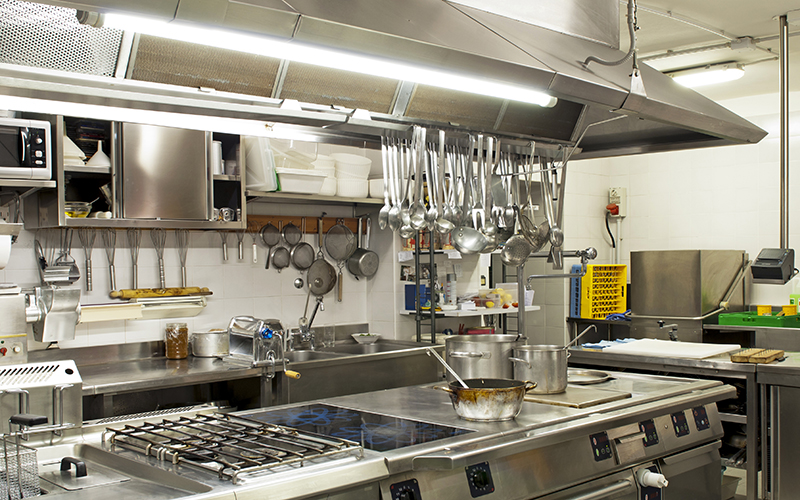Hood Cleaning
Hood Cleaning Service: What is it
Posted on 2018-07-05 00:00:00 By Krista Langston

05Jul
Kitchen exhaust cleaning, or "hood cleaning," is the removal of grease build-up from commercial-grade kitchen exhaust systems and is crucial to maintaining a safe, functional, and compliant kitchen.
Kitchen Fires
Each year, there are approximately 5,600 restaurant fires in the United States, as mentioned in our previous blog,Hood Cleaning: Why You Need It. Kitchen exhaust systems are typically stainless steel, and are therefore not flammable. However, when grease builds up and collects in the hood, vents, fans, ducts, and filters, the unit becomes a dangerous source for kitchen fires. In most cases of kitchen fires, the fire suppression system will turn on, cutting off cooking equipment and fuel powering to try to extinguish the fire. If flames are able to reach any grease build-up in the hood, often times, fires rapidly grow out of control. Most suppression systems will not be able to contain, or extinguish the fire due to the extreme flammability of cooking oils, such as animal and vegetables fats. Fire suppression systems are rarely designed to put out large grease fires, so it is crucial to take preventative action and set up a schedule for regular hood cleaning. For more kitchen fire best practices, see Increasing Commercial Cooking Fire Protection Through Hands-On Employee Training.
Hood Cleaning Awareness
An important part of hood cleaning is knowing that all parts should be inspected and thoroughly cleaned from all grease and cooking oil. Although a unit might look clean from a cook's point of view, there are other parts that collect flammable build-up as well. Behind the visible restaurant exhaust hood and filters, there are vents and fans, as well as ducts that lead to the roof. Restaurant owners and managers should be aware of restaurant hood cleaning processes and know how to inspect a unit upon cleaning. Proper inspection helps to ensure kitchen compliance, functionality, and most importantly, safety.
Hood Cleaning Process
1. Pre-cleaning Inspection
Cleaning service and restaurant owner/manager use service report to note any possible hazards such as, but not limited to, wiring issues, noisy fans, grease collection on the roof)
2. Removal of Filters and Testing Condition of Fans
Restaurant exhaust hood filters are removed to allow access to fans, vents, and ducts. Fans are tested for vibrations and noisiness to confirm they are in proper working order.
3. Roof Cleaned of Grease
Restaurant roof should be cleaned of all grease prior to cleaning the kitchen exhaust system and hood.
4. Plastic Protection of Kitchen Servicing Area and Roof
Plastic bags are secured to hood to funnel grease, chemicals, and water from the build-up removal process to avoid dirtying the floor, roof, and other kitchen equipment.
5. Scraping of Kitchen Exhaust System to Rid High Density Grease and Oil Collection
Initial scraping helps remove major build-up of grease and cooking oils.
6. Application of Food-Safe Chemicals to Soak into Remaining Build-up
Food-safe chemicals are sprayed onto all parts of the exhaust unit and left to soak on any remaining grease build-up after scraping
7. Power Washing of Hood, Vents, Ducts, Fans and Filters
Hood cleaning services use hot water power washing to remove any excess grease build-up after chemicals have been allowed to rest on surfaces, typically spraying around 1,500 - 2,000 p.s.i.
8. Clean Up of Kitchen and Roof
Service teams will wipe down and mop up all remaining water and/or residue from cleaning process in the kitchen and on the roof.
9. Polishing of Kitchen Hood and Work Station
Kitchen hoods should be polished inside and outside, as well as backsplash or other surfaces that appear soiled due to hood cleaning process.
10. Re-testing of Exhaust System Fans
Fans are turned back on to confirm they are in proper working order with no sounds or vibrations.
11. Post-cleaning Inspection
Cleaning service and restaurant owner/manager use service report to go-over and inspect hood cleaning results and kitchen equipment. A copy of the report is left with the restaurant.
12. Certificate of Cleaning Posted on Hood
A certificate of cleaning should be posted on the kitchen exhaust hood(s) after inspection with the cleaning service. It is important that the entire system is cleaned to National Fire Protection Agency (NFPA) #96 code.
For more information and in-depth explanations of the hood cleaning procedures, review the kitchen exhaust cleaning manual provided by PowerWash.com.
Regular Hood Cleaning Schedule
Restaurant hood cleaning should be scheduled regularly to ensure compliance, functionality, and safety of a kitchen. Frequency of exhaust system inspection and cleaning is dependent upon type and volume of cooking provided by a given restaurant or facility. Below is an hood exhaust system inspection schedule provided by the NFPA:
Request Hood Cleaning Services
Grand Natural Inc. offers hood cleaning services and always ensures that restaurant exhaust hoods and systems are compliant with the standards of NFPA #96 code. Call us today to schedule your hood cleaning services at 855.519.5550.
categories
Recent Posts
Waste Cooking Oil Recycling Uses & Ideas
2022-04-18 07:00:00
Benefits of Purifying Used Cooking Oil
2022-04-13 07:00:00
5 benefits of recycling used cooking oil
2021-07-30 07:00:00
Things You Need to Know About Used Cooking Oil Collection
2021-07-30 07:00:00
Getting Set Up is Easy.Call UsSign Up NowORCall Us Today. (855) 519-5550



